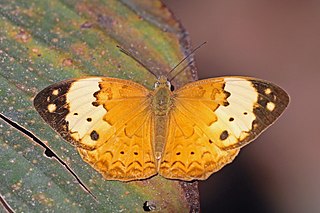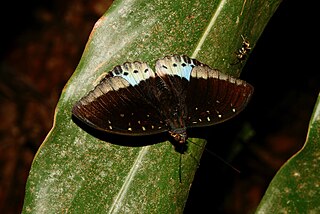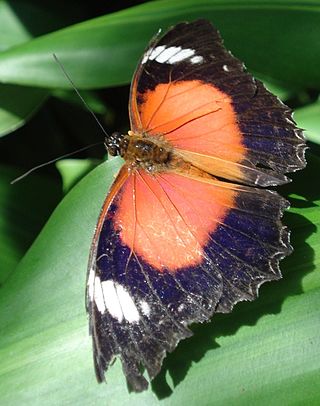
The morpho butterflies comprise many species of Neotropical butterfly under the genus Morpho. This genus includes more than 29 accepted species and 147 accepted subspecies, found mostly in South America, Mexico, and Central America. Morpho wingspans range from 7.5 cm (3.0 in) for M. rhodopteron to 20 cm (7.9 in) for M. hecuba, the imposing sunset morpho. The name morpho, meaning "changed" or "modified", is also an epithet. Blue morphos are severely threatened by the deforestation of tropical forests and habitat fragmentation. Humans provide a direct threat to this spectacular creature because their beauty attracts artists and collectors from all over the globe who wish to capture and display them. Aside from humans, birds like the jacamar and flycatcher are the adult butterfly’s natural predators.

Danaus genutia, the common tiger, is one of the common butterflies of India. It belongs to the "crows and tigers", that is, the Danainae group of the brush-footed butterflies family. The butterfly is also called striped tiger in India to differentiate it from the equally common plain tiger, Danaus chrysippus. The species was first described by Pieter Cramer in 1779.

Papilio polytes, the common Mormon, is a common species of swallowtail butterfly widely distributed across Asia.

Graphium eurypylus, the great jay or pale green triangle, is a species of tropical butterfly belonging to the family Papilionidae.

Euploea eunice, commonly called blue-banded king crow, is a species of butterfly that belongs to the Danaid group of the brush-footed butterflies family. It is found in the Indomalayan realm.

Charaxes bernardus, the tawny rajah, is a butterfly that belongs to the rajahs and nawabs group, that is, the Charaxinae group of the brush-footed butterflies family. This species can be found in India, China, Indomalaya, and onwards to Indonesia.

Cethosia cyane, the leopard lacewing, is a species of heliconiine butterfly found from India to southern China, and Indochina. Its range has expanded in the last few decades, and its arrival in the southern part of the Malay Peninsula, including Singapore, is relatively recent.

Ideopsis vulgaris, the blue glassy tiger, is a butterfly that belongs to the crows and tigers, that is, the danaid group of the brush-footed butterflies family.

Cupha erymanthis, the rustic, is a species of brush-footed butterfly found in forested areas of tropical South Asia and Southeast Asia. The males and females are identical.

Doleschallia bisaltide, the autumn leaf, is a nymphalid butterfly found in South Asia, Southeast Asia, and Australasia. In Australia it is also known as the leafwing.

Faunis is a genus of Asian butterflies in the family Nymphalidae. They are among the butterflies commonly known as fauns. They are relatively small-sized amathusiins, subtly colored in soft browns and violets, and range from China to the Philippines and Sulawesi.

Lexias pardalis, the common archduke, is a butterfly of the family Nymphalidae.

Cethosia, commonly called the lacewings, is a genus of butterflies of the subfamily Heliconiinae in the family Nymphalidae. They are found mainly in southeastern Asia as far south as Australia.

Biblis hyperia, the red rim or crimson-banded black, is a species of brush-footed butterfly that is native to the lower Rio Grande Valley of Texas in the United States, Mexico, the Caribbean, Central America, and South America as far south as Paraguay. Its genus Biblis is so far monotypic, but at least one other undescribed species is suspected to exist.

Cethosia hypsea, the Malay lacewing, is a butterfly of the family Nymphalidae. It is found in from Myanmar to Indonesia and the Philippines.

Cethosia cydippe, the eastern red lacewing, is a species of butterfly from Australia, New Guinea and nearby islands. The Australian subspecies, C. c. chrysippe, is known as the red lacewing butterfly.

Eryphanis automedon, the Automedon giant owl, is a species of butterfly belonging to the family Nymphalidae.

Cethosia hypsea hypsina, the Malay lacewing, is a subspecies of Cethosia hypsea, a butterfly of the genus Cethosia belonging to the family Nymphalidae.

Opsiphanes cassina, the split-banded owlet, is a species of butterfly belonging to the family Nymphalidae.























